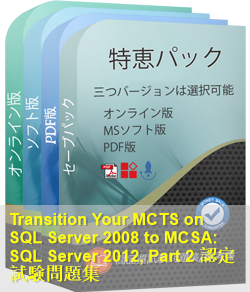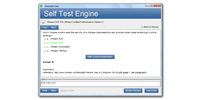あなたの70-458試験合格を100%保証
JPNTestテスト問題集を初めて使用したときにMCSA 70-458試験(Transition Your MCTS on SQL Server 2008 to MCSA: SQL Server 2012, Part 2)に合格されなかった場合は、購入料金を全額ご返金いたします。
JPNTestでMicrosoft 70-458問題集をチョイスする理由
JPNTestは、1週間で完璧に認定試験を準備することができる、忙しい受験者に最適な問題集を提供しております。 70-458の問題集は、Microsoftの専門家チームがベンダーの推奨する授業要綱を深く分析して作成されました。弊社の70-458学習材料を一回のみ使用するだけで、Microsoft認証試験に合格することができます。
70-458はMicrosoftの重要な認証であり、あなたの専門スキルを試す認定でもあります。受験者は、試験を通じて自分の能力を証明したいと考えています。 JPNTest Transition Your MCTS on SQL Server 2008 to MCSA: SQL Server 2012, Part 2 は、MCSAの90の問題と回答を収集して作成しました。Transition Your MCTS on SQL Server 2008 to MCSA: SQL Server 2012, Part 2の知識ポイントをカバーし、候補者の能力を強化するように設計されています。 JPNTest 70-458受験問題集を使用すると、Transition Your MCTS on SQL Server 2008 to MCSA: SQL Server 2012, Part 2に簡単に合格し、Microsoft認定を取得して、Microsoftとしてのキャリアをさらに歩むことができます。
70-458試験の品質と価値
JPNTestのMCSA 70-458模擬試験問題集は、認定された対象分野の専門家と公開された作成者のみを使用して、最高の技術精度標準に沿って作成されています。
70-458の迅速なアップデート対応
70-458試験に変更がございました場合は、現在の試験と一致するよう、瞬時に学習資料を更新することができます。弊社は、お客様に最高、最新のMicrosoft 70-458問題集を提供することに専念しています。なお、ご購入いただいた製品は365日間無料でアップデートされます。
ダウンロード可能なインタラクティブ70-458テストエンジン
MCSAの基礎準備資料問題集には、MCSA 70-458試験を受けるために必要なすべての材料が含まれています。詳細は、正確で論理的なものを作成するために業界の経験を常に使用しているMCSA によって研究と構成されています。
Microsoft Transition Your MCTS on SQL Server 2008 to MCSA: SQL Server 2012, Part 2 認定 70-458 試験問題:
1. ----
You administer a Microsoft SQL Server 2012 instance that contains a financial database hosted on a storage area network (SAN).
The financial database has the following characteristics:
A data file of 2 terabytes is located on a dedicated LUN (drive D).
A transaction log of 10 GB is located on a dedicated LUN (drive E).
Drive D has 1 terabyte of free disk space.
Drive E has S GB of free disk space.
The database is continually modified by users during business hours from Monday through Friday between 09:00 hours and 17:00 hours. Five percent of the existing data is modified each day.
The Finance department loads large CSV files into a number of tables each business day at 11:15 hours and 15:15 hours by using the BCP or BULK INSERT commands. Each data load adds 3 GB of data to the database.
These data load operations must occur in the minimum amount of time.
A full database backup is performed every Sunday at 10:00 hours. Backup operations will be performed every two hours (11:00, 13:00, 15:00, and 17:00) during business hours.
You need to ensure that the backup size is as small as possible.
Which backup should you perform every two hours?
A) NORECOVERY
B) Differential
C) BULK_LOGGED
D) RESTART
E) FULL
F) DBO_ONLY
G) CHECKSUM
H) CONTINUE_AFTER_ERROR
I) SKIP
J) Transaction log
K) COPY_ONLY
L) SIMPLE
M) NO_CHECKSUM
N) STANDBY
2. Note: This question is part of a series of questions that use the same set of answer choices. An answer choice may be correct for more than one question in the series.
You administer a SQL Server 2012 server that contains a database named SalesDb. SalesDb contains a schema named Customers that has a table named Regions. A user named userA is a member of a role named Sales.
UserA is granted the Select permission on the Regions table and the Sales role is granted the Select permission on the Customers schema.
You need to ensure that the Sales role, including userA, is disallowed to select from the Regions table.
Which Transact-SQL statement should you use?
A) EXEC sp_addrolemember 'Sales', 'UserA'
B) REVOKE SELECT ON Object::Regions FROM UserA
C) REVOKE SELECT ON Object::Regions FROM Sales
D) EXEC sp_droprolemember 'Sales', 'UserA'
E) DENY SELECT ON Object::Regions FROM Sales
F) DENY SELECT ON Object::Regions FROM UserA
G) REVOKE SELECT ON Schema::Customers FROM Sales
H) DENY SELECT ON Schema::Customers FROM UserA
I) DENY SELECT OH Schema::Customers FROM Sales
J) REVOKE SELECT ON Schema::Customers FROM UserA
3. Note: This question is part of a series of questions that use the same or similar answer choices. An answer choice may be correct for more than one question in the series. Each question is independent of the other questions in this series. Information and details provided in a question apply only to that question.
You are developing a SQL Server Integration Services (SSIS) project that copies a large amount of rows from aWindows Azure SQL Database database. The project uses the PackageDeployment Model. This project is deployed to SQL Server on atest server.
You need to ensure that the project is deployed to the SSIS catalog on the production server.
What should you do?
A) Configure the output of a component in the package data flow to use a data tap.
B) use an msi file to deploy the package on the server.
C) Add an OnError event handler to the SSIS project.
D) Open a command prompt and run the dtutil /copy command.
E) Run the dtutil command to deploy the package to the SSIS catalog and store the configuration in SQL Server.
F) Open a command prompt and execute the package by using the SQL Log provider and running the dtexecui.exe utility.
G) Open a command prompt and run the dtexec /dumperror /conn command.
H) Open a command prompt and run the dtexec /rep /conn command.
I) create a reusable custom logging component and use it in the SSIS project.
J) Configure the SSIS solution to use the Project Deployment Model.
K) Open a command prompt and run the gacutil command.
4. DRAG DROP
You administer a Microsoft SQL Server database.
You want to import data from a text file to the database.
You need to ensure that the following requirements are met:
- Data import is performed from a Windows batch file.
- Data is loaded as a unit and is minimally logged.
Which data import command and recovery model should you choose? (To answer, drag the appropriate data import command or recovery model to the appropriate location or locations in the answer area. Answer choices may be used once, more than once, or not at all. Answer targets may be used once or not at all. Additionally, you may need to drag the split bar between panes or scroll to view content.)
5. Note: This question is part of a series of questions that use the same or similar answer choices. An answer choice may be correct for more than one question in the series. Each question is independent of the other questions in this series. Information and details provided in a question apply only to that question.
You are writing a SQL Server Integration Services (SSIS) package that transfers data from a legacy system.
Data integrity in the legacy system is very poor. Invalid rows are discarded by the package but must be logged to a CSV file for auditing purposes.
You need to establish the best technique to log these invalid rows while minimizing the amount of development effort.
What should you do?
A) Add a data tap on the output of a component in the package data flow.
B) Use the dtutil /copy command.
C) Run the package by using the dtexec /rep /conn command.
D) Create an OnError event handler.
E) Deploy the package by using an msi file.
F) Create a reusable custom logging component.
G) Run the package by using the dtexec /dumperror /conn command.
H) Use the gacutil command.
I) Use the Project Deployment Wizard.
J) Run the package by using the dtexecui.exe utility and the SQL Log provider.
K) Deploy the package to the Integration Services catalog by using dtutfl and use SQL Server to store the configuration.
質問と回答:
| 質問 # 1 正解: J | 質問 # 2 正解: E | 質問 # 3 正解: J | 質問 # 4 正解: メンバーにのみ表示されます | 質問 # 5 正解: A |


 335 お客様のコメント
335 お客様のコメント





